PERIOD OF FIVE GOOD EMPERORS (A.D. 96 TO 180)
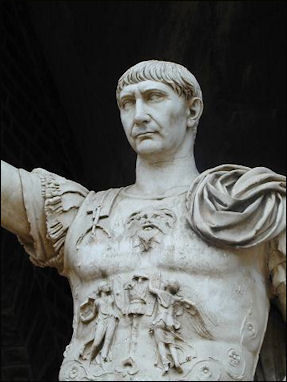
TrajanDescribing the period between A.D. 96 to 180, when Rome was ruled, in succession, by Nerva, Trajan, Hadrian, Antoninus Pius and Marcus Aurelius, the 18th century historian Edward Gibbons wrote, "If man were called to fix the period in the history of the world, during which the condition of the human race was most happy and prosperous, he would, without hesitation, name that which elapsed from [A.D. 96 to 180]."
Marcus Cocceius Nerva (ruled A.D. 96-98) was considered a great Roman ruler. He was a Flavian supporter and advisor and founder of the long-lived Nervan-Antonian dynasty that included Trajan and Hadrian.
The rule of Trajan and Hadrian (A.D. 98-137) is generally regarded as the golden period of the Roman Empire. Peace and prosperity reigned as citizenship was granted to millions of people of different ethnic backgrounds from numerous provinces and gods and ideas moved across the Mediterranean and through the empire.
Antoninus Pius (ruled A.D 161-180) was Hadrian's adopted son. His long reign was marked by stability and peace. There were only minor wars.
Trajan and his Conquests in Eastern Europe and the Middle East
The Spaniard Trajan (A.D. 20-130, ruled from A.D. 98-117) was the first Roman emperor to come from an outlying province. He raised impressive monuments and buildings in Rome, largely paid for with gold and silver plundered from Dacia. Trajan extended the empire to it furthest extent by conquering Dacia (Romania) and Mesopotamia.
Trajan extended the Roman Empire into present-day Romania, Hungary, and Bulgaria in A.D. 106 by defeated Germanic tribes in two Dacian wars (101-102 and 105-106). To achieve victory Trajan built a bridge across the Danube, a startling achievement for its times. The bridge and battles from the Dacian campaign are immortalized in 200 meters of scenes that spiral around the 100-foot-high Trajan column. The campaign ended when the Dacian king, Decebalus, was overthrown.
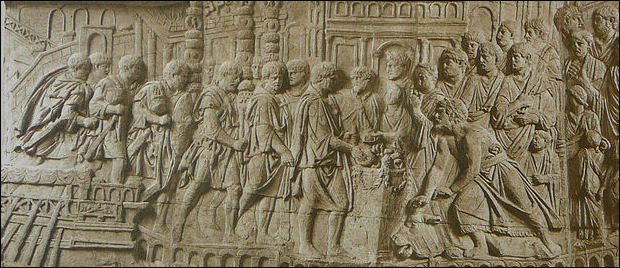
Trajan Column sacrifices
After the conquest of Dacia, the region north of the Danube became a Roman province. Rome shifted the majority of its defenses from the Rhine to the Danube, which became heavily fortified to protect Roman territory from hostile Gothic and Germanic tribes in the north.Trajan's bridge was torn down by Hadrian who felt that it might facilitate a Barbarian conquest of Rome. Roman monuments can be found all over Bulgaria and Romania. The Romanian language evolved from the Roman's Latin tongue.
The Roman city of Canustrum, which spread out over an area of four square miles and had a large legionary fort and an amphitheater that could accommodate 8,000 people, was built on the Danube about 25 miles from present-day Vienna. It was occupied from A.D. 14 to 433, when it was sacked by the Huns.
Trajan's armies extended the Roman Empire to the Persian Gulf by capturing Armenia in A.D. 114 and defeating several Middle eastern kingdoms, including the arch rivals of the Romans, the Parthians. Trajan died in 117 without yet receiving the news of these conquests. Qasr Bashir was a Roman fort on the eastern fringes of Roman Empire in present-day Jordan. Covering three quarters of an acre, it embraced stone walls and three-story-high towers and was situated on a low hill surrounded by rocks and sand.
Column of Trajan
Column of Trajan (at Fori Imperiali) is a 125-five-foot structure with a spiraling scene from Dacian Wars in the Balkans that if unwound would be 656 feet long. Built and inscribed between A.D. 106-113, the column was once topped by a statue of an Trajan, whose ashes and those of his wife are buried underneath its base. Originally it was supposed to be topped by an eagle. The statue of Trajan was destroyed in the Middle Ages.
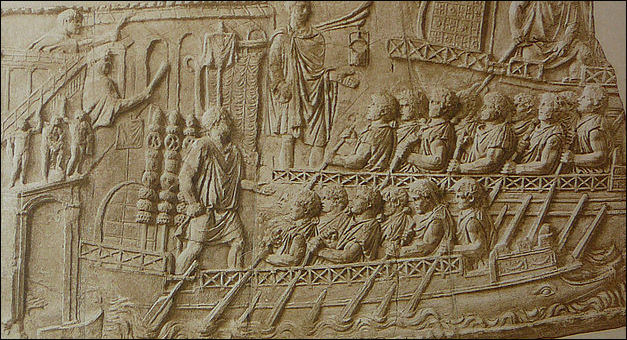
Trajan Column voyage
To follow the narrative of the epic battle one has to walk around and around the column like a "circus horse" as one scholar put it. Even though the sculptures made at the top are bigger than those at the bottom, it is still hard to make them out. The figures were originally painted with bright colors and had metal weapons and the horse had metal harness.
There are a total of 150 separate scenes, the most interesting perhaps being the one that shows the Roman army crossing the Danube on a famous bridge. More attention is focused on the logistics of the battle than the actual fighting
The scenes show the interrogation of prisoners, the removal of booty, and finally the suicide of the Dacian chief while being pursued by the Roman cavalry. Dacian prisoners are treated decently after they have been captured, according to the images, while the Roman prisoners of war are tortured by Dacian women.
Hadrian (ruled from A.D. 117-138)

HadrianHadrian (ruled A.D. 117-138) was the emperor of Rome during the golden age of the Roman Empire. He distinguished himself as a visionary leader, military strategist, poet, artist and architect. He and Trajan oversaw a exceptional period of peace and prosperity. He protected Roman citizens from hostile tribes in Scotland by overseeing the construction of Hadrian's Wall and made peace in Mesopotamia by pulling back from the Euphrates and making peace with the Parthians. Hadrian also designed several monuments in Rome and may have even been the chief architect of the Pantheon.
Hadrian was Trajan's adopted heir. He was born in Rome but, like Trajan, grew up in Spain. Hadrian is famous for his stunning accomplishments in Rome and Athens, but his personality is a puzzle. "His nature," wrote Dio Cassius, "was such that he was jealous not only of the living but also the dead." Another wrote he could be "niggardly and generous, deceitful and straight forward, cruel and merciful, and always in all things changeable."
Hadrian set out from Rome with the purpose of studying the many tribes and cultures in his vast empire. "He marched on foot and bareheaded over the snows of Cledonia and the sultry plains of Egypt," wrote 18th century historian Edward Gibbons. During is rule Hadrians Wall was erected in in northwest England, Hadrian's Gate was built in southern Turkey and Hadrian's Theater was constructed in Carthage. Hadrian united Greece into a confederation with a headquarters in Athens. He codified Athenian Law, finished the Temple of Zeus in Olympia (one of the seven wonders) and rebuilt the shrines in Delphi.
Hadrian also outlawed circumcision which lead to a Jewish revolt.
Hadrian's Male Lover
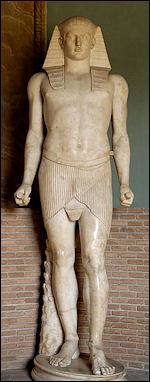
AntinousIt is pretty well established that Hadrian was gay. He fell in love with a handsome boy from Asia Minor named of Antinous (Antinoüs, Antinoos), who became the emperor's companion. After of Antinous, drowned in the Nile im A.D. 130 at the age of 20, according to some theories to sacrifice himself to some mysterious cause, the grief-stricken Hadrian drowned his sorrows by placing statues of him all over the Roman Empire. ["The Creators" by Daniel Boorstin]
Cambridge classic professor Mary Beard wrote in New York Review of Books, “Antinous has a colorful history. He was the young Bithynian “favorite," and presumably lover, of the emperor Hadrian, who drowned in mysterious circumstances in the river Nile in AD 130. “Did he jump, was he pushed or did he merely fall?--- are questions that have never been resolved. Marguerite Yourcenar's idea in her Memoirs of Hadrian that it was more than simple suicide, but a religious self-sacrifice, is one of many appealing, extravagant, and untestable theories. [Source: Mary Beard, New York Review of Books, March 3, 2010]
A statue of of Antinous depicted as the Egyptian god Orisis, with with a pleated loincloth and pharaoh-style striped cobra headdress, was found at Tivoli," Hadrian built a city called Antinoplis to mark the site where his lover died. Later he tried to of Antinous deified and raised a large colonnaded temple at Tivoli dedicated to him.
Hadrian's Achievements
The Pantheon built under Hadrian. First dedicated in 27 B.C. by Agrippa and torn down and reconstructed beginning in A.D. 119 by Hadrian, who may have designed it, the Pantheon was dedicated to all gods, most notably the seven planetary gods. It's name means "Place of all the Gods" (in Latin pan means "all" and theionmeans "gods"). The Pantheon was the most impressive buildings of its time. It's dome was the largest the world had ever seen. See Pantheon, Architecure.
The Pantheon today (in central Rome between Trevi Fountain and Piazza Navona) is the best preserved building from ancient Rome and one of the few buildings from the ancient world that looks pretty much the same today as it did in its time (nearly 2,000 years ago). Based on the profound effect it had on buildings that were built after it, the Parthenon is regarded by some scholars as the most important building ever built. The reason it survived and other great Roman buildings did not is that the Parthenon was converted into a church while other building were scavenged for their marble.
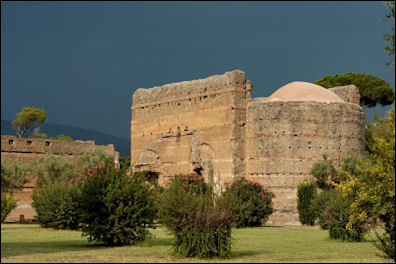
Philosopher's Hall at Hadrian Villa"The effect of the Parthenon," wrote the English poet Shelly, "is totally the reverse of that of St. Peter's. Though not a fourth part of the size, it is, as it were, the visible image of the universe; in the perfection of its proportions, as when you regard the unmeasured dome of heaven...It is open to the sky and its wide dome is lighted by an ever changing illumination of the air. The clouds of noon fly over it, and at night the keen stars are seen through the azure darkness, hanging immovably, or driving after the driven moon among the clouds."
Tivoli (16 miles northeast of Rome) is the home of Villa Adriana, a huge sprawling villa built by the Roman Emperor Hadrian. Completed after 10 years of work, Tivoli contains 25 buildings built on 300 acres of land, including an elaborate bath house fed by water piped in from the Apennines. The buildings are now ruins. Tivoli has been a popular retreat since Roman times. It embraces the ruins of several magnificent villas including Villa Adriana, a lavish complex built by Emperor Hadrian, and Villa d' Este, known for its lavish gardens and plentiful cascading fountains. A pool at the banquet hall is surrounded by columns and statues of gods and caryatids.
Hadrian's villa was completed in A.D. 135. The temples, gardens and theaters are full of tributes to classical Greece. Historian Daniel Boorstin it "still charm the tourist. The original country palace, stretching a full mile, displayed his experimental fantasy. There, on the shores of artificial lakes and on gently rolling hills groups of buildings celebrated Hadrian's travels in the styles of famous cities he had visited with replicas of the best he had seen. The versatile charms of the Roman baths complemented ample guest quarters, libraries, terraces, shops, museums, casinos, meeting room, and endless garden walks. There were three theaters, a stadium, an academy, and some large buildings whose function we cannot fathom. Here was a country version of Nero's Golden House."
One of the most interesting features in the Vatican's Egyptians Museum is a the recreation of an Egyptian-style room found in the palace of the Roman Emperor Hadrian. Among the many Egyptian-style Roman pieces here is a Pharaoh-like rendering of Hadrian's male lover Antinoüs.
Hadrian's Wall
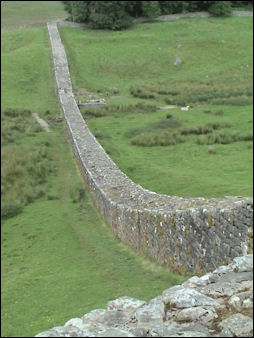
Hadrian's WallHadrain oversaw the building of Hadrians Wall near the present-day border between Scotland and England to protect the unstable British colonies from raids from the fierce Caledonians in present-day Scotland.
Hadrians Wall is the most lasting and famous monument left behind by the Romans in Britain. Stretching from the North Sea to the Irish Sea and constructed to keep "Raiding Scots" out of England the 2000-year-old wall snakes through treeless valleys and over bluffs in a land as big as the sky. The 12 best preserved miles of the wall are located in Northumberland National Park where hills gently rise and fall like waves in a calm sea.
The 74 long mile wall begins near the east coast town of Newcastle and extends to Carlisle in the west. During Roman times it was 10 feet wide and built high enough so that a man standing on the shoulders of another man still couldn't reach the top. Signal stations were set up every mile and every five miles or so there was a castle. As a testimony of how much the Scots were feared 13,000 soldiers and 5,500 horsemen were positioned along the wall. To put these numbers in perspective William the Conqueror captured England with a force of only 7,000 men.
During Roman Times, a traditional fighting ditch stood on the north side of the wall. On the south side was a 10-foot-deep, 20-foot-wide ditch intended to keep smugglers and local inhabitants at bay. Causeways were built across these ditches at the forts. The largest fort enclosed nine acres and housed 1000 men. Each fort had a central headquarters, a chapel for storing sacred weapons, rows of slate-roofed barracks, storage granaries, cookhouses and latrines with running water large enough to accommodate 20 men at one time.
Hadrian's wall was made from 25 million toaster-size stones. In the interior of the wall was poured mortar, and tons of rubble, dirt and gravel. The wall was built at a rate of five wall miles and one fort a year per legion. Although the wall wasn't finished until A.D. 122 most of the work was complete in three years.
Marcus Aurelius (ruled 161-180)
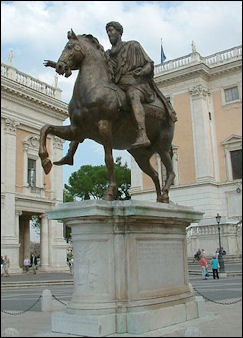
Marcus Aurelius equine statue Marcus Aurelius (born 121, ruled 161-180) was the adopted son of Antonius Pius. He is regarded as a reflective philosopher-emperor and the last of the good emperors. He took the throne at a time when Rome's shortcomings and vulnerability were becoming apparent. The rich were hopelessly decadent, the middle class was disappearing, labor was performed mostly by slaves, and threats were present in the north and the east.
Marcus Aurelius spent two decades fighting four wars and an outbreak of the plague. Germans invaded Italy in 167 and Parthians challenged Roman forces in the Middle East. After the death Lucius Verus, Marcus Aurelius adopted brother and co-ruler of Rome, Marcus Aurelius spent much of his time on the Danubian frontier fending off attacks from German and Gothic tribes.
Marcus Aurelius followed the stoic philosophy. He dressed plainly and lived frugally and wrote a book on philosophy called Meditations that is still quoted today. In regard to his position, Marcus Aurelius wrote: "As the Emperor, Rome is my homeland; but as a man, I am a citizen of the world...Asia and Europe are mere dots on the map, the ocean is a drop of water, Mount Athos is a grain of sand in the universe."
Marcus Aurelius believed that the good of society had precedence over individual comforts. While he was fending off invaders, he passed many reforms, suppressed gladiator spectacles, passed laws protecting slaves. Although his philosophy dovetailed with many Christian doctrines he persecuted Christian because they were regarded as a threat to the empire. His image endures on a famous equestrian statue in Rome.
Meditations is a treatise on the Stoic philosophy extolling the importance of virtue. In modern China, after Premier Wen Jiabao claimed he had read Marcus Aurelius's Meditations nearly 100 times the work became a top seller in China, reaching No. 5 on the bestseller list.
Image Sources: Wikimedia Commons, The Louvre, The British Museum
Text Sources: New York Times, Washington Post, Los Angeles Times, Times of London, Yomiuri Shimbun, The Guardian, National Geographic, The New Yorker, Time, Newsweek, Reuters, AP, Lonely Planet Guides, Compton's Encyclopedia and various books and other publications. Most of the information about Greco-Roman science, geography, medicine, time, sculpture and drama was taken from "The Discoverers" [∞] and "The Creators" [μ]" by Daniel Boorstin. Most of the information about Greek everyday life was taken from a book entitled "Greek and Roman Life" by Ian Jenkins from the British Museum [||].
No comments:
Post a Comment